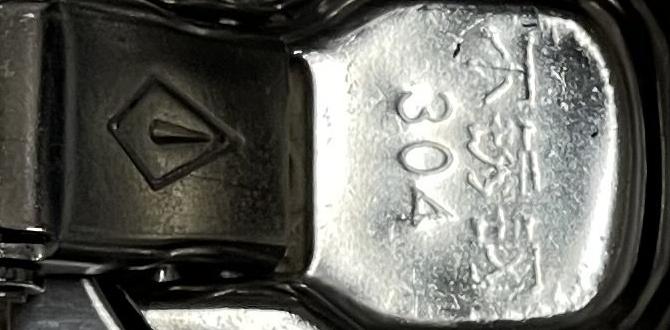Have you ever entered your bathroom only to find a puddle around your toilet? It’s a headache, isn’t it? A broken toilet flange might be the culprit. But don’t fret! You can fix it with some basic tools and a little know-how.
Picture this: You’re hosting friends, and suddenly, the toilet starts dripping. Yikes! What do you do? Instead of calling a plumber right away, why not try to handle it yourself? Learning how to fix a broken toilet flange can save you time and money.
Did you know that a toilet flange helps keep your toilet secure? It connects the toilet to the floor and the plumbing system. If it’s damaged, it can cause leaks and foul smells. That’s no fun! But the good news is, fixing it is not as hard as it may seem.
Ready to dive in? Let’s explore how you can safely and easily fix a broken toilet flange. Your bathroom will thank you!
How To Fix A Broken Toilet Flange: A Step-By-Step Guide A Broken Toilet Flange Can Lead To Leaks And Instability, Making It Essential To Address The Issue Promptly. If You’Re Looking For A Guide On How To Fix A Broken Toilet Flange, You’Re In The Right Place. This Article Will Walk You Through The Steps Required For A Proper Repair, Ensuring That Your Toilet Is Secure And Functional Once Again. Understanding The Toilet Flange Before Diving Into The Repair Process, It’S Important To Understand What A Toilet Flange Is. The Toilet Flange, Or Closet Flange, Is A Ring That Connects The Base Of The Toilet To The Drainpipe In The Floor. It Helps Secure The Toilet In Place And Create A Watertight Seal. Over Time, Flanges Can Become Damaged Due To Corrosion, Movement, Or Improper Installation. Tools And Materials Needed To Fix A Broken Toilet Flange, You’Ll Need Some Basic Tools And Materials: – **Tools:** – Adjustable Wrench – Screwdriver – Hammer – Level – Drill And Bits – **Materials:** – Replacement Toilet Flange – Wax Ring Or Rubber Sealant – Short Screws Or Toggle Bolts (If Necessary) – Wood Shims (If Leveling Is Needed) Step-By-Step Guide: How To Fix A Broken Toilet Flange Step 1: Remove The Toilet 1. **Shut Off The Water Supply**: Turn Off The Water To The Toilet By Locating The Shut-Off Valve, Usually Found On The Wall Behind The Toilet. 2. **Drain The Toilet**: Flush The Toilet To Empty The Tank, Then Sponge Out Any Remaining Water In The Bowl. 3. **Disconnect The Water Supply Line**: Use An Adjustable Wrench To Detach The Supply Line From The Tank. 4. **Unbolt The Toilet**: Remove The Caps Covering The Toilet’S Bolts And Unscrew Them Using A Socket Wrench. Carefully Lift The Toilet Off The Flange And Place It Aside. Step 2: Inspect The Flange Check The Condition Of The Existing Flange. If It’S Cracked, Broken, Or Corroded, It Will Need Replacing. Step 3: Remove The Old Flange 1. **Unscrew And Pull Out The Flange**: If The Flange Is Screwed Down, Remove The Screws. If It Is Glued, You May Need To Pry It Up Using A Hammer And Chisel. 2. **Clean The Area**: Remove Any Debris, Wax Residue, Or Old Sealant From The Floor And The Pipe. Step 4: Install The New Flange 1. **Position The New Flange**: Center The New Flange Over The Drainpipe. Ensure That The Flange’S Bolts Align With The Toilet’S Base Holes. 2. **Secure The Flange**: If It Comes With Mounting Holes, Drill Into The Floor And Use Screws Or Toggle Bolts To Securely Fasten It. Confirm That The Flange Is Level Using A Level Tool. Step 5: Set The Wax Ring Place A New Wax Ring On Top Of The Flange. If You’Re Using A Rubber Seal, Follow The Manufacturer’S Instructions For Placement. Step 6: Reinstall The Toilet 1. **Align The Toilet**: Carefully Lower The Toilet Onto The Flange, Aligning The Bolts With The Holes In The Base. 2. **Fasten The Bolts**: Secure The Toilet By Tightening The Bolts Gradually, Alternating Sides To Prevent Rocking. 3. **Reattach The Water Supply**: Connect The Water Supply Line And Turn The Valve Back On. Step 7: Test For Leaks Turn On The Water And Allow The Tank To Fill. Flush The Toilet And Check For Any Leaks Around The Base And Flange. Ensure Everything Is Tight And Secure. Conclusion Now That You Know How To Fix A Broken Toilet Flange, You Can Tackle This Repair With Confidence. Regular Maintenance And Awareness Of Your Plumbing Can Prevent Issues Like This From Occurring In The Future. By Following The Steps Outlined Above, Your Toilet Should Be As Good As New!

How to Fix a Broken Toilet Flange
A broken toilet flange can be a real headache. Luckily, fixing it is often simple! First, gather your tools: a new flange, screws, and a wrench. Remove the old flange carefully. Clean the area well. Then, attach the new flange, ensuring it sits flush against the floor. Tighten everything securely. Did you know a loose flange can cause leaks? Taking care of it early can save you money and hassle later. So, why wait? Get started on that repair today!What is a Toilet Flange?
Definition and purpose of a toilet flange. Common materials used for toilet flanges.A toilet flange is a pipe fitting that connects the toilet to the floor. It holds the toilet securely in place and keeps sewer gases out of your home. The flange is important for proper toilet installation, helping with a strong seal.
Toilet flanges are often made from:
- Plastic
- Metal
- Wax
Each material has its own benefits, such as strength and resistance to rust.
What is the purpose of a toilet flange?
The purpose of a toilet flange is to create a strong base for the toilet. It also helps to connect the toilet drain to the main sewage pipe. A good flange keeps your toilet stable and prevents leaks.
What are common materials used for a toilet flange?
- Plastic: Lightweight and resistant to corrosion.
- Metal: Strong and durable, but may rust.
- Wax: Creates a tight seal, but can wear down over time.
Signs of a Broken Toilet Flange
Water leaks around the base of the toilet. Wobbling or unstable toilet.Have you noticed water sneaking around the base of your toilet? That could mean trouble! Another sign is a toilet that shakes or wobbles like it’s trying to dance. These problems can hint at a broken toilet flange. When your toilet feels less like a throne and more like a funhouse ride, it’s definitely time to check!
| Signs of a Broken Toilet Flange | Description |
|---|---|
| Water Leaks | Look for puddles or wet spots around the toilet’s base. |
| Wobbling Toilet | If your toilet feels like a seesaw, it’s time to investigate! |
Remember, ignoring these signs won’t make them disappear. Instead, they might just send your plumbing bills skyrocketing! A little checking now could save you a lot of mess later. So, keep an eye out!
Tools and Materials Needed
Essential tools for fixing a toilet flange. Recommended replacement materials.Fixing a toilet flange requires a few important tools and materials. First, you need these tools:
- Wrench – To tighten bolts easily.
- Screwdriver – For loosening screws.
- Utility Knife – To cut any old wax seal.
- Measuring Tape – To get accurate measurements.
Next, gather these materials for replacement:
- New Wax Ring – Seals your toilet to the flange.
- Flange Repair Kit – Fixes damage to the flange.
- Bolts and Nuts – Secure the toilet to the flange.
Having the right tools and materials makes fixing a broken flange much easier.
Step-by-Step Guide to Fixing a Broken Toilet Flange
Preparing the area: Safety tips and necessary precautions. Removing the toilet: Detailed instructions and best practices. Assessing the damage: How to inspect the flange. Types of repair: Options for fixing or replacing the flange.First things first, you want a clean workspace. Clear everything around the toilet, so you don’t trip over any rubber ducks or toilet paper mountains. Remember, safety first! Use gloves and goggles because your eyes are important, but I bet your friends wouldn’t mind seeing you looking like a toilet superhero!
Next, let’s remove the toilet. Turn off the water supply like a pro. Use a wrench to unscrew the bolts. It’s easier than trying to open a pickle jar! Just lift the toilet off and put it aside. Now, take a peek at the flange. Is it cracked like your grandma’s old teacup? Inspect it closely.
If it’s damaged, don’t fret! You can either fix or replace it. Options may include using a repair ring or a complete flange replacement. Check this handy table for repairs:
| Repair Type | Description |
|---|---|
| Repair Ring | A quick fix for minor damage, it fits over the old flange. |
| Full Replacement | Completely swap out the flange if it’s really broken. |
And voila! You’re now ready to put the toilet back. With these steps, your toilet will be sitting pretty again!
Repair Methods: Which is Right for You?
Temporary fixes (e.g., flange extender, rubber gasket). Permanent solutions (e.g., replacing the flange, installing a new flange).There are two ways to tackle a broken toilet flange: temporary and permanent fixes. For a quick solution, you can use a flange extender or a rubber gasket. These are like band-aids for your toilet! They can hold up until you get a more lasting fix. On the other hand, if you want to say goodbye to your troubles, try replacing the flange or installing a new one. It’s a bit of work, but it’s like upgrading from a tricycle to a sports car!
| Type of Fix | Description |
|---|---|
| Temporary Fix | Flange extender or rubber gasket to hold things together. |
| Permanent Solution | Replace the flange or install a new one for lasting strength. |
How to Prevent Future Flange Issues
Tips for maintaining a toilet flange. Setting proper installation techniques during initial setup.To keep your toilet flange in good shape, follow these tips. Proper installation is key. Make sure the flange sits flat on the floor. Use the right screws and sealants. Regular checks help too. Look for cracks and damage. Treat your flange with care to avoid leaks.
What are effective maintenance tips for a toilet flange?
Some simple tips include:
- Check for loose screws regularly.
- Keep the area clean and dry.
- Avoid standing on the toilet to prevent stress on the flange.
FAQs about Toilet Flange Repairs
Common questions and expert answers. Troubleshooting common issues after repair.Got a broken toilet flange? We’ve got your back! Many ask, “Why does my flange keep leaking?” Well, it might be loose or cracked. Check it for damage after repairs. Another common question is, “How do I know if I did it right?” A flush test will do the trick. And if you hear weird noises, it could mean the bolts need tightening. Don’t worry; even toilets have their off days!
| Question | Answer |
|---|---|
| Why does my flange leak? | It could be loose or broken! |
| How to check if my repair worked? | Perform a flush test! |
| What if it makes strange noises? | You may need to tighten some bolts! |
Conclusion
In summary, fixing a broken toilet flange involves a few simple steps. First, remove the toilet. Next, replace or repair the flange. Finally, reattach the toilet carefully. Remember to check for leaks afterward. If you need more details, look for step-by-step guides online. With patience, you can successfully fix your toilet flange and prevent future problems!FAQs
Here Are Five Related Questions On The Topic Of Fixing A Broken Toilet Flange:To fix a broken toilet flange, first, you need to turn off the water supply. Then, you can remove the toilet from the top of the flange. Next, replace or repair the flange to make it strong again. Finally, put the toilet back and connect everything. After that, turn on the water and check for leaks!
Sure! Please provide the question you would like me to answer.
What Are The Signs That Indicate A Toilet Flange Is Broken Or Damaged?You might see water around your toilet. That means the flange could be broken. The toilet may rock or wobble when you sit on it. You might also hear strange noises when you flush. These signs mean you need to check the flange.
What Tools And Materials Are Needed To Repair Or Replace A Broken Toilet Flange?To fix a broken toilet flange, you need a few tools and materials. First, gather a wrench to loosen bolts. You’ll also need a putty knife to clean the old flange. Get a new toilet flange, some screws, and a rubber gasket. Lastly, grab a level to make sure everything is straight when you put it back together.
How Do You Remove A Toilet Safely To Access The Broken Flange?To remove a toilet safely, first, turn off the water supply. Next, flush the toilet to empty it. Then, use a sponge to soak up any leftover water. After that, unbolt the toilet from the floor and lift it gently. Now, you can fix the broken flange.
What Are The Steps Involved In Replacing A Broken Toilet Flange With A New One?To replace a broken toilet flange, start by turning off the water supply. Next, take off the toilet by unscrewing it from the floor. Remove the old flange and clean the area. Then, put the new flange in place and screw it down. Finally, put the toilet back, connect the water, and test it to make sure there are no leaks.
Are There Any Temporary Fixes For A Broken Toilet Flange Until A Permanent Solution Can Be Implemented?Yes, you can use some temporary fixes. First, try using a toilet flange repair kit from the store. These kits usually have special screws and plastic parts. You can also put some strong tape around the flange to hold it in place. Remember, these are just quick fixes; you should get a permanent repair soon!








